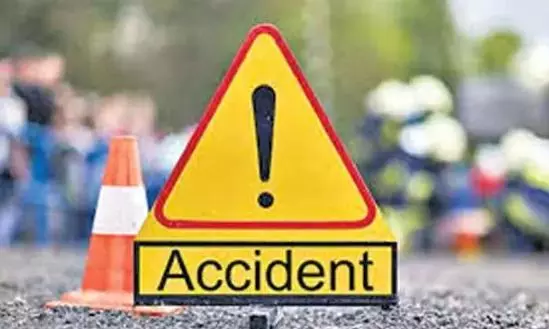Heavy Vehicle Blind Spots An Underrated Issue In City
"A lot of times, two-wheelers try to overtake from the left, which makes it difficult for us to react in time. Braking becomes nearly impossible considering the speed oncoming vehicles must be at”: A lorry driver

HYDERABAD: Friday’s accident, where a six-year-old was run over by a tipper lorry in Dundigal, draws attention to a quiet danger on the roads – the large blind spots around vehicles, especially the large ones like buses and lorries – where two-wheeler riders and pedestrians remain invisible to the driver until it’s too late.
“People drive so close to us thinking we can see everything. But there is hardly any truth in it,” said Sainath, a lorry driver transporting construction material. “We cannot really see someone immediately close to us, our (rearview) mirrors do not show that. A lot of times, two-wheelers try to overtake from the left, which makes it difficult for us to react in time. Braking becomes nearly impossible considering the speed oncoming vehicles must be at,” he added.
Speaking of blind spots, Kiran Kumar Goli, founder of road safety website Safe Tortoise, said, “This is a common yet underestimated risk. While the part to drive safely remains on the driver of the vehicle, it is almost impossible for a heavy vehicle driver to be careful especially around the side and the rear, considering the way these vehicles are designed.”
He said that smaller vehicles and pedestrians, who are more vulnerable to these blind spots, are supposed to be extra careful while driving. “Avoid venturing too close to these heavy vehicles and never try to cut them. Two-wheelers get enough time to react, heavy vehicles do not, because of their size and design,” he said.
Sarika Dave, a resident of Himayatnagar, who often drops her kids to school said, “It gets scary to have a heavy vehicle right next to you. There are a lot of buses coming on the same route. I often find myself startled and start maintaining a safe distance.”
The front blind spot of a heavy vehicle extends about 20 feet from the front, while the back blind spot extends 30 feet from the vehicle’s rear.
The left blind spot starts from the driver’s side of the vehicle, around the driver’s door and goes back the width of one lane for about 20-30 feet. Hint for a rider or commuter to know if they are in the blind spot area is to see if they can see the driver’s face in the side mirror. If that is not visible to the rider, then they are not visible to the driver.
The right blind spot is longer than the others. It starts around the passenger door and extends around 20 feet past the end of the truck. Then, it starts covering both the near and the next lanes to the right, eventually angling and tapering off on the right.

